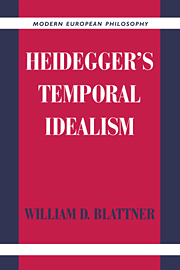Book contents
- Frontmatter
- Contents
- Acknowledgments
- A Note on Sources
- Introduction. Ontology, Phenomenology, and Temporality
- 1 Care as the Being of Dasein
- 2 Originary Temporality
- 3 World-Time and Time-Reckoning
- 4 The Ordinary Conception of Time and Disengaged
- 5 Heidegger's Temporal Idealism
- Conclusion. The Consequences of the Failure of Heidegger's Temporal Idealism
- Bibliography
- Index
4 - The Ordinary Conception of Time and Disengaged
Published online by Cambridge University Press: 05 June 2012
- Frontmatter
- Contents
- Acknowledgments
- A Note on Sources
- Introduction. Ontology, Phenomenology, and Temporality
- 1 Care as the Being of Dasein
- 2 Originary Temporality
- 3 World-Time and Time-Reckoning
- 4 The Ordinary Conception of Time and Disengaged
- 5 Heidegger's Temporal Idealism
- Conclusion. The Consequences of the Failure of Heidegger's Temporal Idealism
- Bibliography
- Index
Summary
How does Heidegger conceive time in the traditional sense, time as the insignificant series of moments (perhaps even spanless instants) that belong to nature? Thus far Heidegger has introduced us to originary temporality and world-time. The former is the nonsequential manifold of being-ahead, being-amidst, and being-already. The latter is the sequential series of times that are dated, significant, spanned, and public. But does Dasein not sometimes experience time in the traditional sense, the pure ticking away of moments independent of human concerns and planning? Yes, there is such an experience of time, and it is not just an illusion. The tradition has not just made a mistake. Dasein does sometimes encounter times that are “contentless.” These times are distinguishable from one another insofar as they form a sequence, a series defined by the relations earlier than and later than, and insofar as one of them is in each case current, and the rest are either past or future. How does Heidegger fit this conception of time, which he calls the “ordinary” conception, into his system?
The Change-Over from the Occurrent to the Available
In order to come to terms with ordinary time and the way it depends on world-time, we must first understand the emergence of the occurrent out of the available. I shall give here a very compressed version of this emergence, for it is the focus of some debate what exactly it is.
Information
- Type
- Chapter
- Information
- Heidegger's Temporal Idealism , pp. 185 - 229Publisher: Cambridge University PressPrint publication year: 1999
